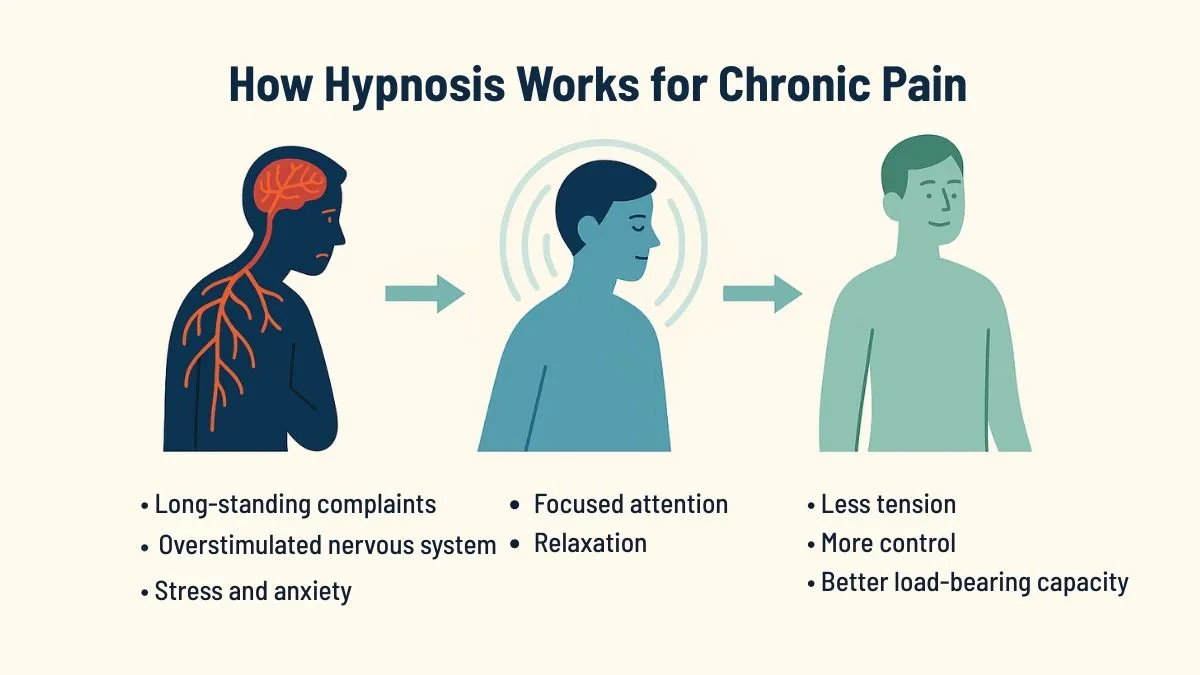Hypnosis in chronic pain can provide support when you live with persistent symptoms on a daily basis. With focused attention, suggestions and self-hypnosis you learn to deal differently with pain signals, tension and emotions. The goal is not a guarantee of being pain free, but more control, relaxation and space to live a more active life with quality – always in addition to regular care.
What is hypnosis in chronic pain?
In hypnosis in chronic pain, you work with focus and imagination to influence your perception of pain. You learn to direct your attention, interpret body sensations differently and dampen automatic stress reactions. Many people experience more grip on their complaints and a greater capacity to cope with daily life. Results vary per person; it remains customized, tailored to your goals and context.
Why is chronic pain so complex?
Chronic pain is more than “a place that hurts.” The nervous system, emotions, attention, sleep, stress and expectations come into play. Pain can linger “in the system,” so to speak, even after the original trigger is less relevant. Therefore, dealing with pain requires a broad approach in which physiological, psychological and behavioral factors are considered together. Hypnosis addresses this by working on both perception and coping skills.
- Pain perception consists of sensory, emotional and cognitive components.
- Stress and hypervigilance can amplify pain experience.
- Negative expectations can unintentionally perpetuate complaints (nocebo effect).
How does hypnosis work for chronic pain?
During a session, under expert guidance, you bring yourself into a concentrated, receptive state. In that state, purposeful suggestions and images are used to reduce tension, increase safety and interpret pain differently.
- Influencing attention: you learn to move away from brooding thoughts toward helping focus.
- Regulation of tension: breath, relaxation and imaginary coolness/warmth help calm the body.
- New associations: you pair pain stimuli with more neutral or supportive meanings.
Research suggests that hypnosis can regularly provide relief from chronic pain and that brain regions involved in pain processing may respond differently when a person is in hypnosis. The magnitude of the effect varies; a careful, individualized approach remains essential.
Hypnosis is an adjunct and not a substitute for medical care. Treatment choices and changes in medication always coordinate with the treating physician.
For whom can hypnosis be appropriate?
Hypnosis in chronic pain is suitable for people who are motivated to actively practice and learn new skills step by step. Think of back and neck pain, joint pain, fibromyalgia or neuropathic pain. Hypnosis can also be supportive when stress, insomnia or anxiety surrounding pain play a role.
- You are open to guidance as well as practicing yourself (self-hypnosis).
- You are looking to supplement existing care, not replace it.
- You want to work toward greater peace, grip and quality of life.
When is hypnosis not appropriate?
With severe psychiatric problems or acute dysregulation, hypnosis is usually not the first choice. Safety and stability take precedence. We always discuss whether hypnosis is appropriate, and we are happy to work with your primary care physician or specialist for a well-tailored approach.
What can you expect from a trajectory?
A course of hypnosis in chronic pain usually consists of several sessions with clear goals. You will be given techniques to practice at home as well, so that you build up an effect in everyday life.
- Introduction and goals: we explore your symptoms, context and expectations.
- Induction: we induce a focused, receptive state in a calm and safe manner.
- Suggestions and imagination: focused on pain relief, calming and helping meaning.
- Self-hypnosis: you will learn a short, achievable practice routine for at home.
The rhythm is practical: prefer short and consistent practice to occasional long practice. This way you build skills that you can use in different situations.

Left: Long-term symptoms, overstimulated nervous system, stress and anxiety.
Center: Focused attention, relaxation, new associations.
Right: Less tension, more control, better coping.
Self-hypnosis: practicing in everyday life
Self-hypnosis is a core component of hypnosis in chronic pain. You will learn a compact exercise that calms you down and activates helping suggestions in minutes. The power is in repetition and application at times relevant to you.
- Schedule set practice times (e.g., in the morning and before bed).
- Pair self-hypnosis with everyday routines (after a walk, after a work block).
- Use a neutral scale (e.g., 0-10) to track your experience over time.
Many people gradually find that they can switch to relaxation more quickly and that their reaction to pain stimuli becomes less intense. This can increase carrying capacity in work, family and social activities.
Hypnosis in chronic pain and the care team
Hypnosis is consistent with multidisciplinary pain care. A common language and consistent communication help increase safety and trust. When hypnosis is used in consultation with physicians or physical therapists, a clear division of roles often emerges: medical treatment remains leading, while hypnosis employs attention, tension and coping.
- Clear agreements with prescribing physician regarding any medication.
- Feedback on goals and progress, where desirable and appropriate.
- Focus on achievable, functional goals (sleep, freedom of movement, daily routine).
Frequently asked questions about hypnosis in chronic pain
Is hypnose bij chronische pijn bewezen effectief?
Onderzoek beschrijft vaak verlichting bij chronische pijn door hypnose, met gunstige effecten op pijnbeleving en kwaliteit van leven. De mate van effect verschilt per persoon. Het wordt gezien als een zinvolle aanvullende methode binnen pijnmanagement.
Werkt hypnose bij chronische pijn voor iedereen?
Niet iedereen reageert even sterk, maar veel mensen ervaren merkbare verlichting in belasting, slaap en stress. Succes hangt samen met regelmaat van oefenen en een goede match van technieken.
Voel je altijd ontspanning tijdens een sessie?
Niet altijd. Soms komen er emoties los, wat onderdeel van het proces kan zijn. Veel mensen ervaren daarna juist meer rust en ruimte. De sessies worden afgestemd op jouw tempo en draagkracht.
Zit de pijn 'tussen de oren'?
Die uitdrukking heeft een negatieve lading, alsof iemand zich aanstelt. De werkelijkheid is anders: je voelt pijn met je brein. Dat maakt de pijn niet minder echt, maar verklaart wel waarom betekenis, aandacht en verwachting de pijnervaring kunnen versterken of juist verzachten.
Veel problemen wortelen in onbewuste patronen. Als we ze met alleen bewuste gedachten konden oplossen, hadden we dat al gedaan. In de hypnotherapie zien we geregeld dat pijn samenhangt met eerdere emotionele ervaringen. Het onderbewustzijn kent die verbanden vaak wel, maar ons gewone bewustzijn niet. Met hypnose kunnen deze verbanden meestal zorgvuldig worden teruggevonden en bijgestuurd.
Kortom: de pijn is echt en wordt daadwerkelijk gevoeld. Door te werken met het brein en het onderbewustzijn ontstaat er ruimte om het pijnsysteem te kalibreren en verlichting te ervaren.
Kan hypnose helpen om medicatie te verminderen?
Sommige mensen ervaren minder behoefte aan pijnmedicatie. Als er aanleiding is om te veranderen, gebeurt dat uitsluitend in overleg met de voorschrijvend arts. Hypnose vervangt geen medische behandeling.
Wat is het verschil tussen hypnose en ontspanningsoefeningen?
Ontspanning is vaak een onderdeel van hypnose, maar hypnose gaat verder: je werkt ook met suggesties, betekenisgeving en selectieve aandacht. Dat maakt het een bredere interventie dan ontspanning alleen.
<


